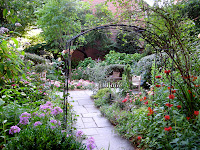The Great Bridges of Central Park
SUNDAY September 11, 2016
THE STORY
There isn't single thing in Central Park that happened by chance. Every detail, every view, every vista was carefully thought out by the two original landscape architects - Calvert Vaux and Frederick Law Olmsted. It’s impossible not to see beauty everywhere you turn walking through the park, and many artists before us have taken inspiration there.
Our focus this Sunday will be on the Bridges of Central Park. The bridges were a solution to one of the design problems. There were three types of roadways in the Park, walking paths, carriage paths and bridal paths. The three roadways twisted around the park and the bridges were designed to keep traffic flowing and to prevent the people, the carriages and the horse riders from intersecting one another. The park has 40 bridges and
each one is completely unique.
Our sketch day will focus on three bridges located in the southernmost portion of the park and will include an example of the three types - brick steel and stone. Bring a stool or something to sit on - it helps.
WHERE and WHEN:
We will meet at the Columbus Circle Entrance at 10:00 AM. Look for people sketching. We’ll enter the park at about 10:15.
First stop Greyshot Arch: Located in the park at about West 61-62 Streets: Greyshot Arch, popular with bikers and runners, was built by Vaux in 1860. The arch is made of white-gray gneiss, while its balustrade has been crafted from New Brunswick sandstone and decorated with fleur-de-lis carvings. One of the most frequently used arches in Central Park, this arch is 80 feet long and ten feet high. From 10:15 to 11:15
Second Stop - Pinebank Arch: Located in the park at about W 62 Street. Pine Bank Arch is one of five of the original seven cast-iron bridges remaining in Central Park. The 80-foot span carries pedestrians over the bridle path 11 feet below. Built in 1861 by J.B. and W.W. Cornell Ironworks One of the parks' few remaining cast iron bridges. It was rescued from decline and lovingly restored in the 1980s. It was a bridge over the bridal path. A ball field was built in the 1930s and this portion of the bridal path was abandoned making the bridge more of an ornamental structure. Approximately from 11:15 to 12:15
LUNCH We will have a picnic lunch in the area near the Dairy. Your choices will be to buy food from the park vendors, or lunch at the dairy, leave the park to buy food or pack your own feast Approximately from 12:15 to 1:30
Third Stop - Gapstow Bridge: Located in the park at about E 62 Street. Maybe the most iconic bridge in Central Park. It is so beautifully designed and so frequently drawn, painted and photographed that it is almost a visual cliche. It’s actually the second bridge built on this spot. The original bridge was a mix of wood and stone and supposedly was much more elaborate. It was replaced with the stone arched bridge in 1896. There are tremendous skyline views at this location. Brides come to be photographed there in their wedding dresses and the area is heavily frequented by tourists. There will be lots to sketch. Approximately 1:30 to 3:00 PM
Show and Tell: Will be al fresco starting at 3:00. It will be a chance for us to socialize, tell stories and share our sketches.
Unconfirmed Bonus:
Dr. Sketchy might me starting up again at 4 PM on Sunday. It's posted on Facebook but not on their website - so it's not clear. Dr. Sketchy is Not Urban Sketching (NUS) but is a different and unique sketching opportunity, defnot to everyone's taste.
If you can’t find us
call Mark at 973-809-9128
There are no fees or attendance taken. All drawing skill levels are welcome.



















